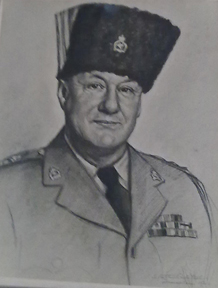
Major General Frederick Gerard Peake,, known as Peake Pasha, was a British Army and police officer and creator of the Arab Legion.
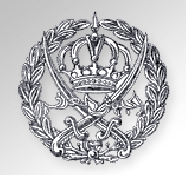
The Arab Legion was the police force, then regular army, of the Emirate of Transjordan, a British protectorate, in the early part of the 20th century, and then of the Hashemite Kingdom of Jordan, an independent state, with a final Arabization of its command taking place in 1956, when British senior officers were replaced by Jordanian ones.
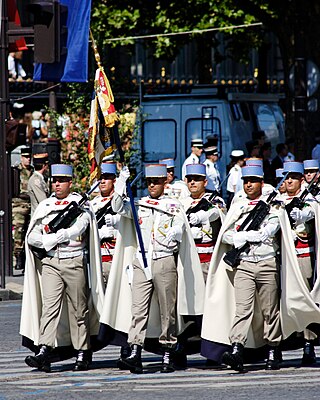
Spahis were light-cavalry regiments of the French army recruited primarily from the Arab and Berber populations of Algeria, Tunisia and Morocco. The modern French Army retains one regiment of Spahis as an armoured unit, with personnel now recruited in mainland France. Senegal also maintains a mounted unit with spahi origins as a presidential escort: the Red Guard.

The Anglo-Iraqi War was a British-led Allied military campaign during the Second World War against the Kingdom of Iraq, then ruled by Rashid Ali al-Gaylani who had seized power in the 1941 Iraqi coup d'état with assistance from Germany and Italy. The campaign resulted in the downfall of Gaylani's government, the re-occupation of Iraq by the British, and the return to power of the Regent of Iraq, Prince 'Abd al-Ilah, a British ally.

The Battle of Abu Tellul was fought on 14 July 1918 during the Sinai and Palestine Campaign of World War I after German and Ottoman Empire forces attacked the British Empire garrison in the Jordan Valley. The valley had been occupied by the Egyptian Expeditionary Force (EEF) from February 1918 when Jericho was captured. Following two raids east of the River Jordan by the EEF the first in March and second in April the defence of the valley became the responsibility of the Desert Mounted Corps.

The 1st Cavalry Division was a regular Division of the British Army during the First World War where it fought on the Western Front. During the Second World War it was a first line formation, formed from Yeomanry Regiments. It fought in the Middle East before being converted to the 10th Armoured Division.
Iraqforce was a British and Commonwealth formation that came together in the Kingdom of Iraq. The formation fought in the Middle East during World War II.

The Battle of Palmyra was part of the Allied invasion of Syria during the Syria-Lebanon campaign in World War II that took place from 21 June to 2 July 1941. British mechanised cavalry and an Arab Legion desert patrol broke up a Vichy French mobile column north-east of the city of Palmyra. This provoked the surrender of the Vichy garrison at Palmyra.
The Household Cavalry Composite Regiment was a temporary, wartime-only, cavalry regiment of the British Army consisting of personnel drawn from the 1st Life Guards, 2nd Life Guards and Royal Horse Guards. It was active in 1882 for service in the Anglo-Egyptian War, in 1889–1900 during the Second Boer War, from August to November, 1914 during the opening months of World War I and in World War II.
The Desert Force, also known as the Desert Patrol, was a paramilitary force of Transjordan. Its main task was to guard Jordanian borders with neighboring Iraq, Saudi Arabia and Syria as well as to provide protection for oil pipelines of the Iraq Petroleum Company (IPC). It also participated in campaigns of Syria and Iraq during World War II.
This is the order of battle for the Syria–Lebanon campaign, a World War II campaign between the Western Allies and Vichy France during June and July, 1941.
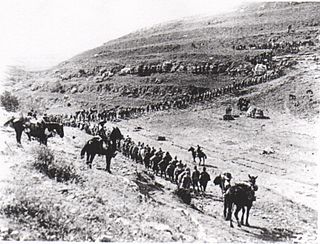
The First Transjordan attack on Amman and to their enemy as the First Battle of the Jordan took place between 21 March and 2 April 1918, as a consequence of the successful Battle of Tell 'Asur which occurred after the Capture of Jericho in February and the Occupation of the Jordan Valley began, during the Sinai and Palestine Campaign of World War I. During the First Transjordan attack large incursions into Ottoman territory occurred. Firstly the Passage of the Jordan River, was successfully captured between 21 and 23 March, followed by the first occupation of Es Salt in the hills of Moab between 24 and 25 March. The First Battle of Amman took place between 27 and 31 March when the Anzac Mounted Division and the Imperial Camel Corps Brigade were reinforced by two battalions of 181st Brigade followed by a second two battalions from the 180th Brigade and artillery. The Fourth Army headquarters located in Amman was strongly garrisoned and during the battle received reinforcements on the Hejaz railway, the strength of which eventually forced the attacking force to retire back to the Jordan Valley between 31 March and 2 April. The Jordan Valley would continue to be occupied by the Egyptian Expeditionary Force (EEF) through the summer until the middle of September 1918 when the Battle of Megiddo began.
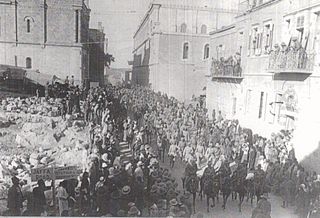
The Second Transjordan attack on Shunet Nimrin and Es Salt, officially known by the British as the Second action of Es Salt and by others as the Second Battle of the Jordan, was fought east of the Jordan River between 30 April and 4 May 1918, during the Sinai and Palestine Campaign of the First World War. The battle followed the failure of the First Transjordan attack on Amman fought at the beginning April. During this second attack across the Jordan River, fighting occurred in three main areas. The first area in the Jordan Valley between Jisr ed Damieh and Umm esh Shert the Egyptian Expeditionary Force (EEF) defended their advanced position against an attack by units of the Seventh Army based in the Nablus region of the Judean Hills. The second area on the eastern edge of the Jordan Valley where the Ottoman Army garrisons at Shunet Nimrin and El Haud, on the main road from Ghoraniyeh to Amman were attacked by the 60th (London) Division many of whom had participated in the First Transjordan attack. The third area of fighting occurred after Es Salt was captured by the light horse brigades to the east of the valley in the hills of Moab, when they were strongly counterattacked by Ottoman forces converging on the town from both Amman and Nablus. The strength of these Ottoman counterattacks forced the EEF mounted and infantry forces to withdraw back to the Jordan Valley where they continued the Occupation of the Jordan Valley during the summer until mid September when the Battle of Megiddo began.
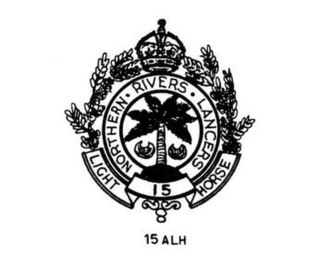
The 15th Light Horse Regiment was a mounted infantry regiment of the Australian Army during the First World War. The regiment was raised in Palestine in 1918, from soldiers that had been serving with the Imperial Camel Corps Brigade, and assigned to the 5th Light Horse Brigade. During the war the regiment fought against the forces of the Ottoman Empire, in the Sinai and Palestine Campaign and was awarded fourteen battle honours. During the inter-war years, the regiment was re-raised as a part-time unit based in the Northern Rivers region of New South Wales. It was later converted to a motor regiment during the Second World War but was disbanded in 1944 without having been deployed overseas. In the post war period, the regiment was briefly re-formed, before being amalgamated into the 1st/15th Royal New South Wales Lancers in 1956.

This is the order of battle for the Battle of Megiddo (1918), the concluding engagement of the Sinai and Palestine Campaign of the First World War. The Entente's Egyptian Expeditionary Force, commanded by General Edmund Allenby and composed mainly of British, Indian, Australian and New Zealand troops, with a small French and Armenian contingent, cooperated with the Arab Northern Army, which was part of the Arab Revolt and was under the overall command of the Emir Feisal, in an all-out offensive against the Yıldırım Army Group, part of the army of the Ottoman Empire.
The Third Transjordan attack by Chaytor's Force, part of the British Empire's Egyptian Expeditionary Force (EEF), took place between 21 and 25 September 1918, against the Ottoman Empire's Fourth Army and other Yildirim Army Group units. These operations took place during the Battle of Nablus, part of the Battle of Megiddo which began on 19 September in the final months of the Sinai and Palestine campaign of World War I. Fought on the right flank and subsidiary to the Battle of Nablus, the Third Transjordan attack began northwards, with the assault on Kh Fasail. The following day a section of Chaytor's Force, attacked and captured the Ottoman Empire's 53rd Division on the main eastwards line of retreat out of the Judean Hills across the Jordan River. Retreating columns of the Yildirim Army Group were attacked during the battle for the Jisr ed Damieh bridge, and several fords to the south were also captured, closing this line of retreat. Leaving detachments to hold the captured bridge and fords, Chaytor's Force began their eastwards advance by attacking and capturing the Fourth Army garrison at Shunet Nimrin on their way to capture Es Salt for a third time. With the Fourth Army's VIII Corps in retreat, Chaytor's Force continued their advance to attack and capture Amman on 25 September during the Second Battle of Amman. Several days later, to the south of Amman, the Fourth Army's II Corps which had garrisoned the southern Hejaz Railway, surrendered to Chaytor's Force at Ziza, effectively ending military operations in the area.

The First Battle of Amman was fought from 27 to 31 March 1918 during the First Transjordan attack on Amman of the Sinai and Palestine Campaign of the First World War. The 60th (London) Division and the Anzac Mounted Division attacked the Ottoman garrison at Amman deep in enemy occupied territory, 48 kilometres (30 mi) from their front line, after capturing Es Salt and Shunet Nimrin. The Egyptian Expeditionary Force (EEF) was successfully counterattacked by Ottoman Empire forces forcing them to retreat back to the bridgeheads captured on the Jordan River.

The Raid on Nekhl was the second of three battles by British forces to recapture the Sinai Peninsula during the Sinai and Palestine Campaign of World War I. Egyptian Expeditionary Force (EEF) mounted forces travelled into the centre of the Sinai Peninsula to attack and push the last Ottoman Army garrisons back into Palestine.
The British Troops in Palestine and Trans-jordan was a British Army command in Mandatory Palestine and the Emirate of Transjordan.
The Trans-Jordan Frontier Force Long Service and Good Conduct Medal was an official United Kingdom award relating to the Emirate of Transjordan, which was a British protectorate.
